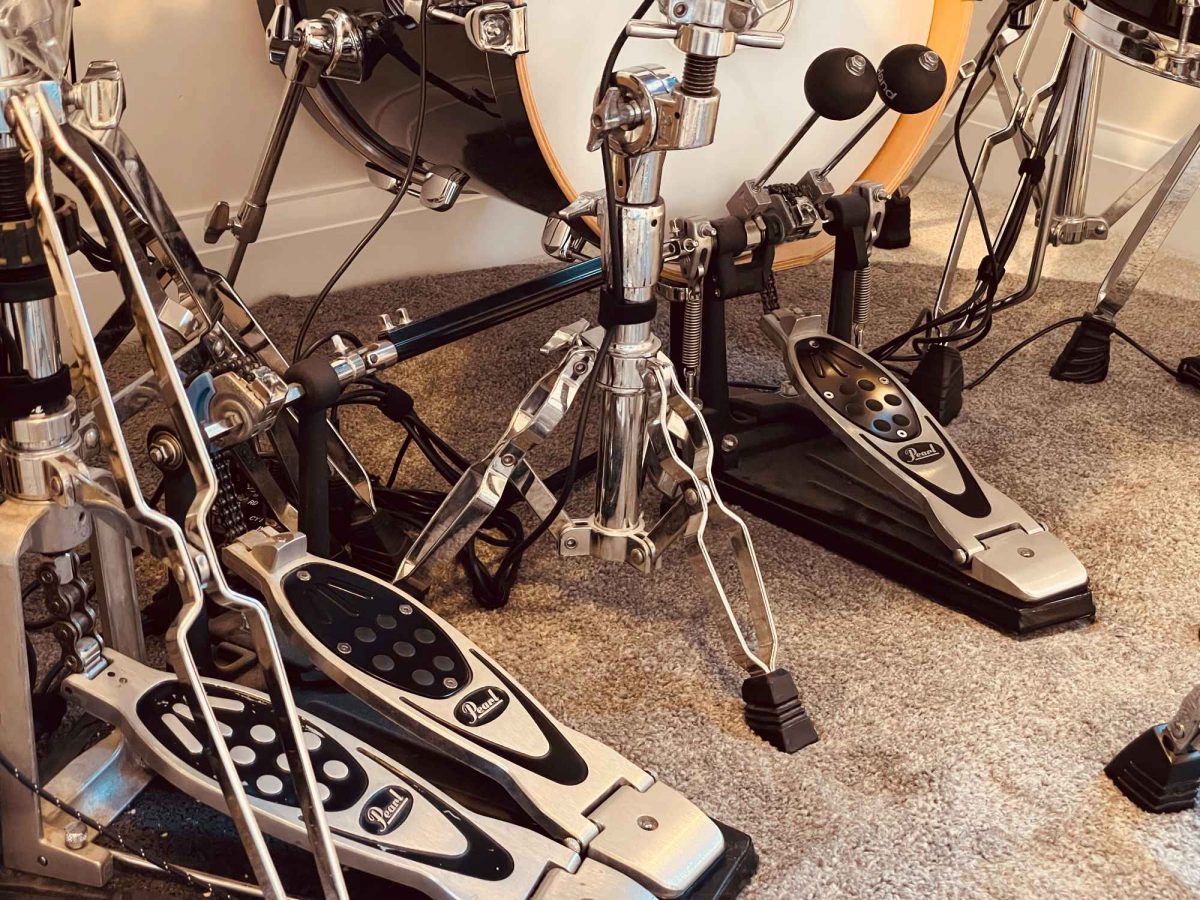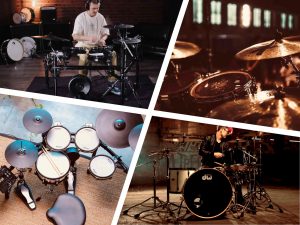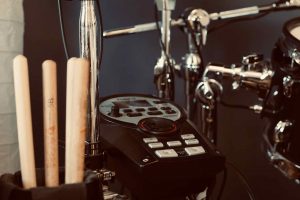Looking for a new double bass drum pedal? Here, we’ll look at the best double bass drum pedals for electronic drums, and what to consider when buying a new pedal for your electronic kit.
Summary: Best double pedals for eDrums
Budget:
Intermediate:
High-end:
Can you use any kick pedal for electronic drums?
Yes, electronic drums are designed to work with any kick pedal. That means a bass drum pedal used on an electronic kit is exactly the same as one used on an acoustic kit. The one thing you should consider though is to avoid using a felt beater as if your bass drum trigger has a mesh head, the felt can wear it away.
If you already have a preferred kick pedal you’d like to use on your electronic kit, don’t worry, you can easily change the beater if it doesn’t have a plastic beater.
If you need to buy a new set of double kick beaters, then why not consider a low-volume one designed for electronic drums? These beaters can marginally reduce the volume your eKit makes, but don’t expect miracles. Instead, read my guide on soundproofing your apartment drums for more detailed information on how to reduce the volume of your electronic kit.
Meanwhile, here are three electronic bass drum beaters to consider.
Note: Some of the links on this page are affiliate links. If you buy a product after clicking on one of these links, eDrumHub may receive a small commission at no extra cost to you. This helps us maintain this site.
Roland KDB-200
These are the beaters I use, made with a rubber head that absorbs a bit of the impact without changing the feel of your kit.
KAT Percussion Silent Strike Beater
The tennis ball style head on this beater is good for drummers who like to ‘bury the beater’ as it reduces the ‘double-slap’ you can get on a springy mesh head.
Pick up a pair at Guitar Center
Tama Soft Sound Beater
This beater is actually designed to reduce the volume of acoustic bass drums, but can still be used on electronic drums.
Do double bass pedals work on electronic drums?
Yes, double bass drum pedals work on electronic drum kits. This is the case for the vast majority of electronic drums, bar some of the lower-end models which do not use standard kick pedals, such as some kits in the Roland TD-2 range.
Remember, for the best results, you should use a plastic or rubber bass drum beater instead of a felt beater when using your double pedal with your electronic drums. Many eDrum kits use kick towers or bass drum pads with mesh heads. Using a felt head on these pads can wear the mesh head down over time and eventually break. A plastic or rubber beater avoids this issue, and you can also use a bass drum patch for added protection.
Finally, the trigger pads on some kick drum towers can be quite small, usually only just large enough for your two beaters. You may need to take care when lining up and mounting your beater to ensure the left one doesn’t clip the rim or plastic housing of the trigger. For the round-up of double bass pedals below, we’ve picked ones with either beater that are mounted close together or have at least one beater than can be moved horizontally to minimise the space required.
What should you look for to find the best bass drum pedal?
There are a few things to consider when shopping for a bass drum pedal for your electronic drums:
- Adjustability: A good double pedal is one that can be configured to your preferences. If you’re new to drumming, you won’t need all this adjustability, but as you develop, you can begin tinkering and testing variations in your pedal set-up to make playing easier.
- Drive type: The drive describes how the pedal is connected to the beater, and the main types are chain drive, belt drive, or direct drive. Chain and belt are quite similar, though some drummers find a belt drive has a lighter feel. On the chain side, pedals will be either single or double chain, with single having a slightly lighter feel, and double having more horizontal stability. Direct drive pedals have a solid link between the footboard and the beater, enabling even faster and more powerful playing. Typically, heel-down players tend to like direct drive and heel-up prefer chain or belt.
- Cam type: Cams are what connect the drive to the beater and provide a pivot for the beater to rotate around. Most pedals come with linear cams which have the same radius throughout and provide a constant feel. Some pedals come with offset cams which accelerate the beater the closer it gets to the head. This is useful for fast double bass players looking to maintain speed and power. Some pedals come with interchangeable (like the Pearl Eliminator) or adjustable cams (like the DW 9002), allowing you to customise the feel.
- Plastic beaters: As noted above, most bass drum pads use mesh heads, and plastic beaters help to reduce wear. The vast majority of double pedals come with multi-faced beaters of different materials, but you can buy beaters separately if needed
- Beater spacing: Beaters should be fairly close together or include the ability to adjust horizontally, to be sure they fit your kick drum tower
- Smooth action: The best double pedals will have a smooth, silent action, providing minimal friction. Remember to regularly lubricate your pedal to maintain this quality
- Standard or longboard footplates: Some pedals come with extra-long footplates called longboards. These pedals tend to be preferred by players with larger feet or those that use the heel-and-toe technique. They feel a little different to play, so try before you buy, or be prepared for a period of adaptation.
- Built to last: Finally, even if you’re a novice drummer, it can be good to buy a pedal that’s built to last. That doesn’t mean buying the most expensive pedal out there, instead, skipping the very bottom of the rung, no-name brands and going for a reputable brand with a design that’s been around for years. If you’re short on cash, don’t forget you can always consider buying used, but be prepared to give your pedal a bit of a tune-up if you do so.
Budget double bass drum pedals
Our budget picks are generally priced under $250 and are good options for beginner drummers. These pedals provide the basics but don’t offer all the customizability of their more expensive counterparts. That’s not an issue for beginners, who should be focused on developing technique rather than adapting their pedals around their playing style.
Tama HP30TW
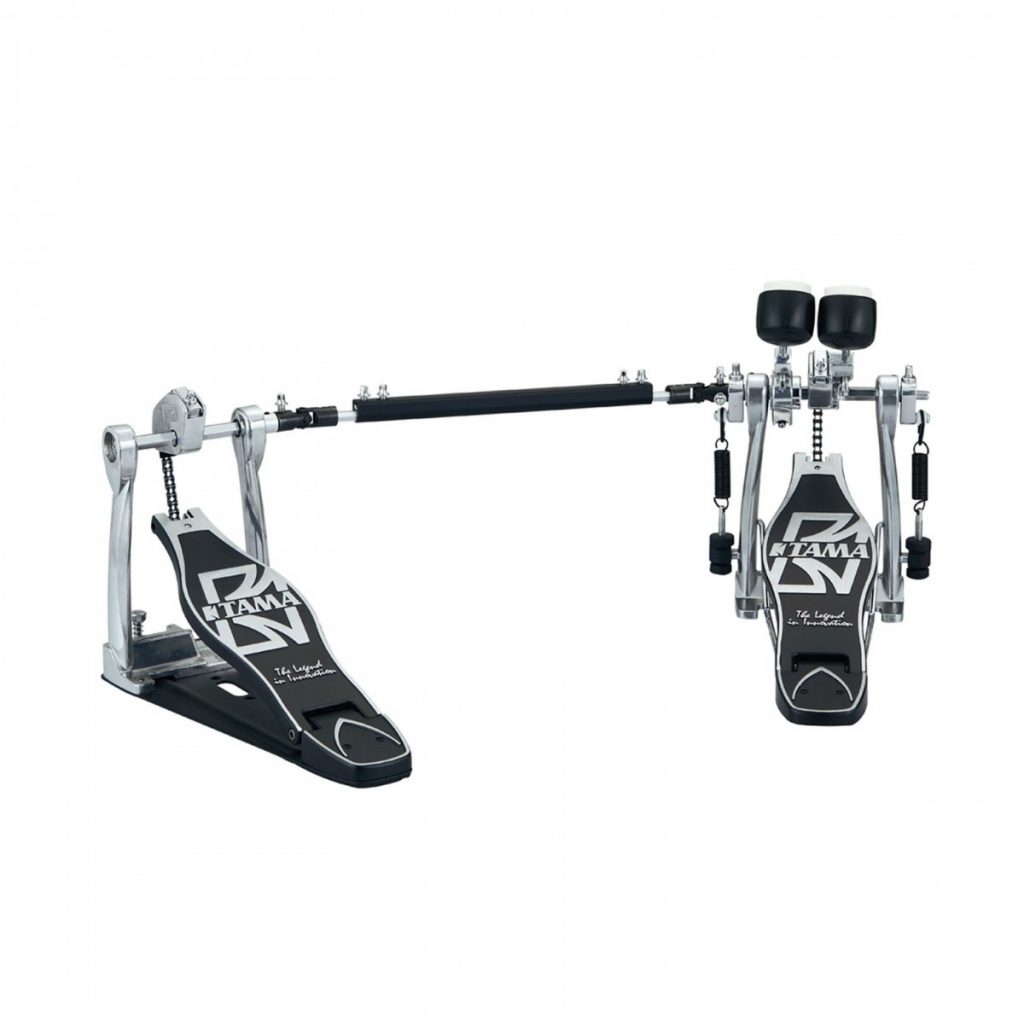
The Tama HP30TW, also known as the Tama Standard Double Pedal, is the cheapest double pedal worth considering, available for just $149/£139.
The pedal features the same type of offset cam as the higher-end Iron Cobra 900 Power Glide, albeit with a single chain instead of a double, and a standard tension adjustment. On top of that, the pedal beater angle can be adjusted, which isn’t always possible on pedals in this price range.
Of course, at this price, there are some cost-cutting measures, most notably the fact the right-hand pedal does not have a solid footplate, using the bass drum itself for stability. This is typical of budget pedals and fortunately doesn’t affect playability.
Meanwhile, the supplied beaters only have two faces – plastic and felt – as opposed to four faces on more expensive pedals. This doesn’t matter too much for electronic drum players, as you’ll only want to use the plastic side on your mesh bass drum head.
The beaters on the Tama standard pedal are also very close together, with the right-hand pedal integrated into the Powerglide mechanism. This is also good for use on eKits with small bass drum trigger towers, as both beaters strike the bass drum within a small area.
All in all, the HP30TW is a good choice for beginners on a low budget, but experienced players may want to look towards the higher end for more adjustability options.
Buy the Tama Standard Double Pedal at Guitar Center or Thomann
Pearl P-922 Powershifter
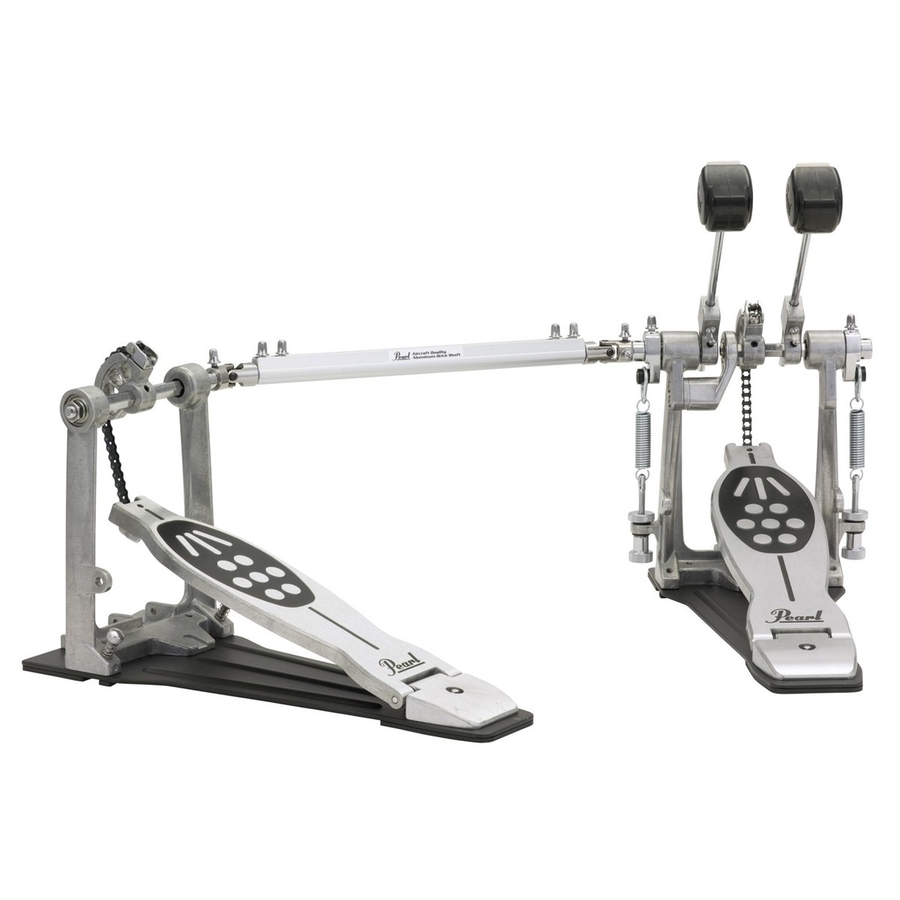
The Pearl P-922 is a tried and tested design that has been available for around 20 years, previously known as the P-122TW.
This is another entry-level double pedal with features that have trickled down from the higher end, specifically the ‘powershift’ footplates, which allow the pedalboard angle to be adjusted by sliding the heel forwards and backwards, changing the feel from light to strong.
The beater angle is also adjustable alongside the spring tension and features a solid base plate on both pedals.
This pedal differs from the Tama HP30TW by having a linear cam instead of offset. Some drummers prefer this due to the natural feel, though it can be more difficult to generate speed and power with a linear cam. This matters less on electronic kits than acoustic ones because the sensitivity of the bass drum trigger can be adjusted. If you get the chance, it’s a good idea to try before you buy, and base your choice on which feel you prefer.
This pedal has a right-hand beater that can be adjusted horizontally, allowing you to get the beaters close together if your kick has a small triggering area.
Curiously, the P-922 features a simplified hoop clamp than the older P-122TW, which is slightly harder to access on the newer pedal than the older version. If you’re on a budget and need a gigging pedal for quick set-up and tear-down, it may be a good idea to check eBay for the older model in good condition.
All in all, this is a quality pedal for drummers on a budget. I’ve owned the older model since 2005 and found it to be comparable in build quality to my Pearl Eliminator, lacking only in the adjustability department compared to its premium equivalent.
Buy the Pearl Powershifter at Thomann for £189/€219. Alternatively, if you prefer a longboard-style pedal, try the P-932 available at Guitar Center or Thomann for $305/£205/€237.
Mapex Armory Double Pedal
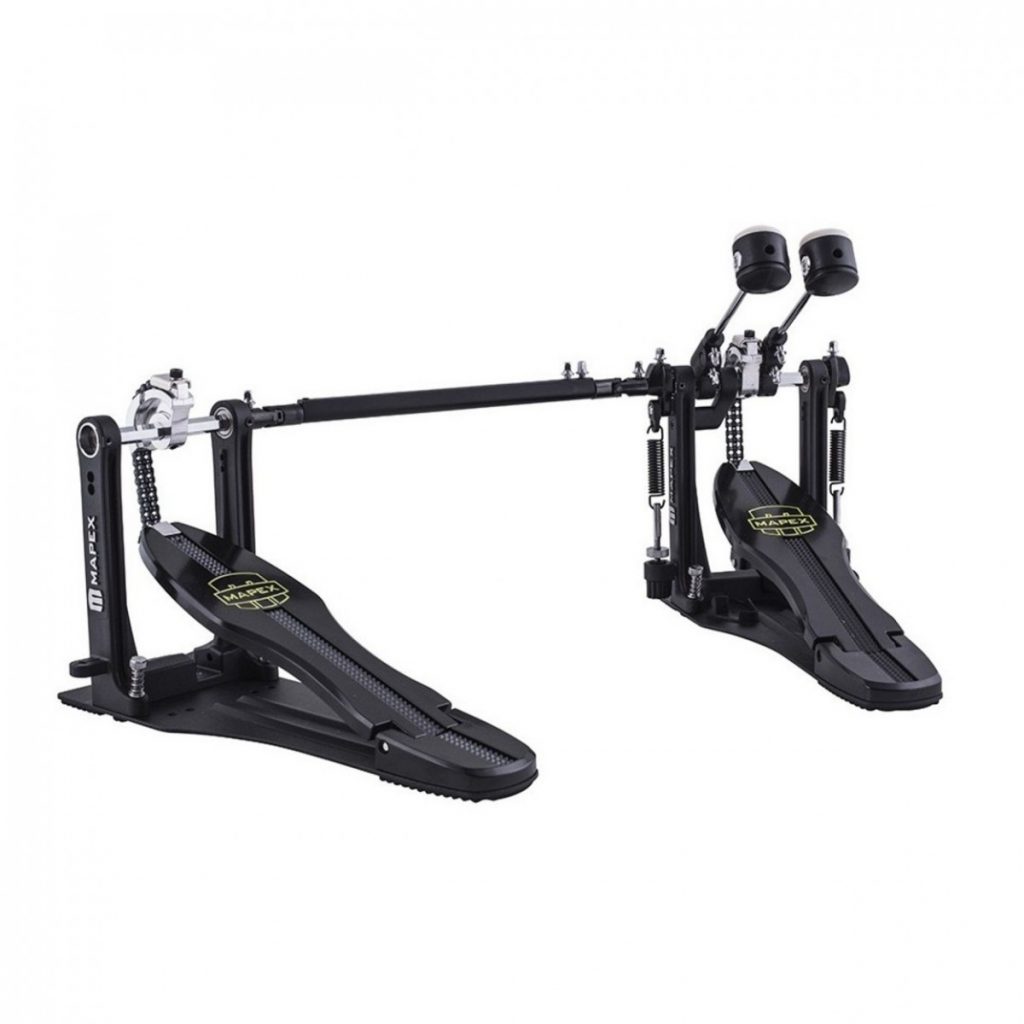
The Mapex Armory double pedal is a longboard pedal, essentially a budget version of the Mapex Falcon. Like the other budget pedals here, it features elements that have trickled down from that model. There are two model numbers – a P800TW and a newer P810TW model costing $299/£288/€329.
Unlike the other budget pedals though, this pedal uses a double-chain drive, which helps add a bit of stability to the pedalboards. The beaters also distinguish this pedal against rivals. Firstly, they feature memory locks to set the beater length, a feature usually reserved for high and mid-range pedals. This is great if you want to perform live with your electronic kit, as it means you can quickly set up your pedal with your preferred beater length.
The beaters also have a unique feature – the ability to add or remove weights from the head, which affects the playing feel. The pedal comes with 10g and 20g weights for each head, which can be inserted and locked in place using a provided allen key.
I have owned the P800TW for a number of years and preferred using either the 10g weight or no weight at all, as the heavier the weight the more inertia on the head. This adds power but means more effort is needed to get going, and in my opinion the extra weight makes the pedals feel a bit sluggish to play on.
The pedalboards themselves are longboards, which may be preferable for some players. Personally, I play heel-up fairly close to the heel plate and find the Mapex Armory a little harder to achieve this with compared to shortboard pedals like the Pearl Powershifter or Eliminator. If you’re not sure if you prefer standard or longboard pedals, it’s always a good idea to try a set out in a store if you can.
Buy the Mapex Armory Double Pedal at Guitar Center or Thomann
Mid-range bass drum pedals
We’re defining our midrange pedals as starting from around $400-600. These pedals offer a lot more customisation than the budget range, making them more suited to intermediate and experienced drummers who have their technique nailed and want to experiment with pedal setups. The selection below offers essentially all you might need from a double bass drum pedal for your electronic kit. Meanwhile, our high-end price bracket is only worth stepping up to for double bass connoisseurs with deep pockets looking for the best of the best.
Pearl Eliminator Redline
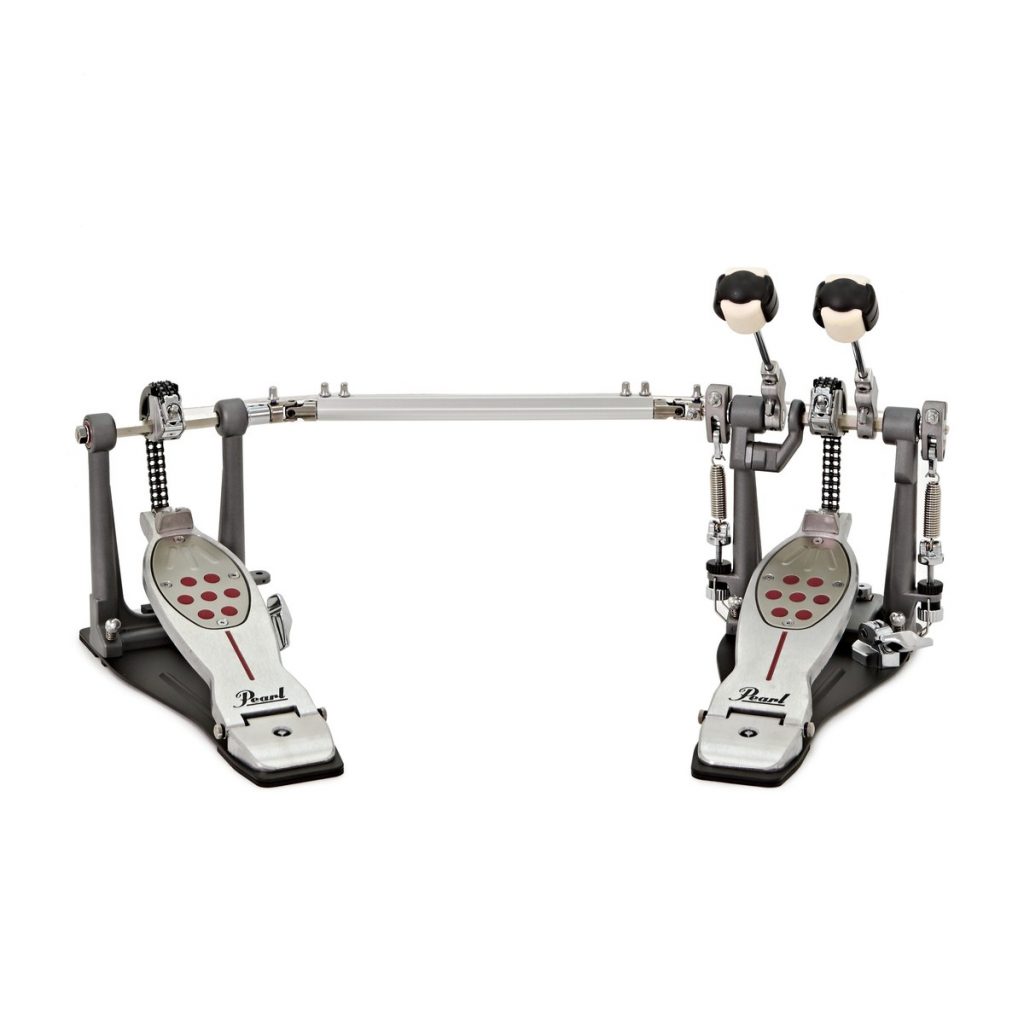
The Pearl Eliminator Redline is an update on the original Pearl Eliminator, which has been around for over 20 years. It is essentially an upgrade on the P-922, adding numerous adjustability options. Core among this is the addition of four interchangeable cams, including two linear cams offering slightly different pedal feel, a blue offset cam, and a red aggressive offset cam for ultimate power and speed, which many metal drummers swear by.
The pedal comes in either a chain or belt version, which can be attached to the cam in different positions to alter the angle of the pedalboard. The beaters offer a choice of four different faces (stick to a plastic face for eDrums!), and are equipped with memory locks to set and forget the beater length. Finally, the footplates feature removable toe stops and customisable rubberised plates, which can be rotated to move the extra grip either to the top or middle of the pedal to suit where you place your feet.
The Redline version of the Pearl Eliminator adds new ‘ninja bearings’ originally designed for skateboards, helping to reduce friction and allow for a smooth feel.
Comparing the Eliminator to the Powershifter, the main structure of the pedal is the same, but looking closely you can see that many of the fixings and components are beefed up and add more adjustments.
Personally, I picked up an Eliminator single for my acoustic kit and a double for my electronic kit and prefer the feel of the blue cam over both the Pearl Powershifter and Mapex Armory.
If you’re on a budget, you can always check eBay for the older model of this pedal, or consider the Eliminator Solo Red or Black – a cut-down version which drops the interchangeable cam. In practice, you will most likely stick with one cam, so the Solo could be a good option if you’re sure you don’t want to experiment with different cams.
Buy the Pearl Eliminator at Guitar Center or Thomann for $559/£429/€489.
DW 5002

The DW 5002 is the little brother of the 9002, but that doesn’t stop it from being recognised as an industry standard in its own right. The main difference between the two is that the 5002 has a traditional mechanism while the 9002 uses a patented free-floating mechanism.
This means the 5002 while being very smooth, has slightly more resistance than the 9002 in the pedal feel. Some drummers prefer this over the marginally lighter feel on the 9002, which is why the 5002 is still considered a pro drum pedal despite not being the top-of-the-range model.
The 5002 is available with two types of mechanisms – turbo and accelerator, with turbo offering a linear cam and accelerator offering increased speed and sensitivity. Unlike other pedals here, the cams are not interchangeable, meaning you need to pick the one that’s right for you from the start.
As a result, it’s a good idea to try before you buy – both for the mechanism, and if you have the budget, to compare the 9002 against the 5002. The various 5002 models come in at around $599/£632/€719.
Buy the DW 5002 at Guitar Center or Thomann.
High-end bass drum pedals
These high-end options are money-no-object and come in at over $800. If you’re an experienced double bass drum player and absolutely need the best of the best, then these are worth considering. However, it’s always worth trying out one of our mid-range picks too and considering if they meet your needs. In many cases, you can buy two mid-range double pedals for the price of one high-end pedal, which may be worth considering if you gig regularly and would rather not have to take your pedals from your practice kit each time.
Pearl Demon Drive

The Demon Drive is a direct-drive pedal that first came out in 2009 and is the top-of-the-range double pedal in Pearl’s range. The action on this pedal is so smooth and direct that it feels like there’s no pedal at all. Usually, the left pedal on a double tends to feel slightly more sluggish than the right due to the shaft, but on the Demon Drive, that isn’t the case, it feels just as smooth as the right-hand pedal.
As you might expect, this pedal offers immense customisation. Alongside all the usual adjustable settings of a high-end pedal, the Demon Drive features footplates that can be transformed from standard to longboard by simply flipping over the heel plate. Meanwhile, the direct drive mechanism can be adapted to move the starting position of the beaters close or further from the bass head.
This all means the Demon Drive can be made to feel very different depending on how you set it up. The only real limitation is the hours of tweaking required to get it set up to your preferences!
Of course, all this comes at a high price point, costing $879/£699/€799. Plus, you’ll want to replace the all-felt beaters with plastic ones or our e-drum beater options above, to maximise the durability of your mesh bass drum head.
Buy the Pearl Demon Drive at Guitar Center or Thomann
DW 9002
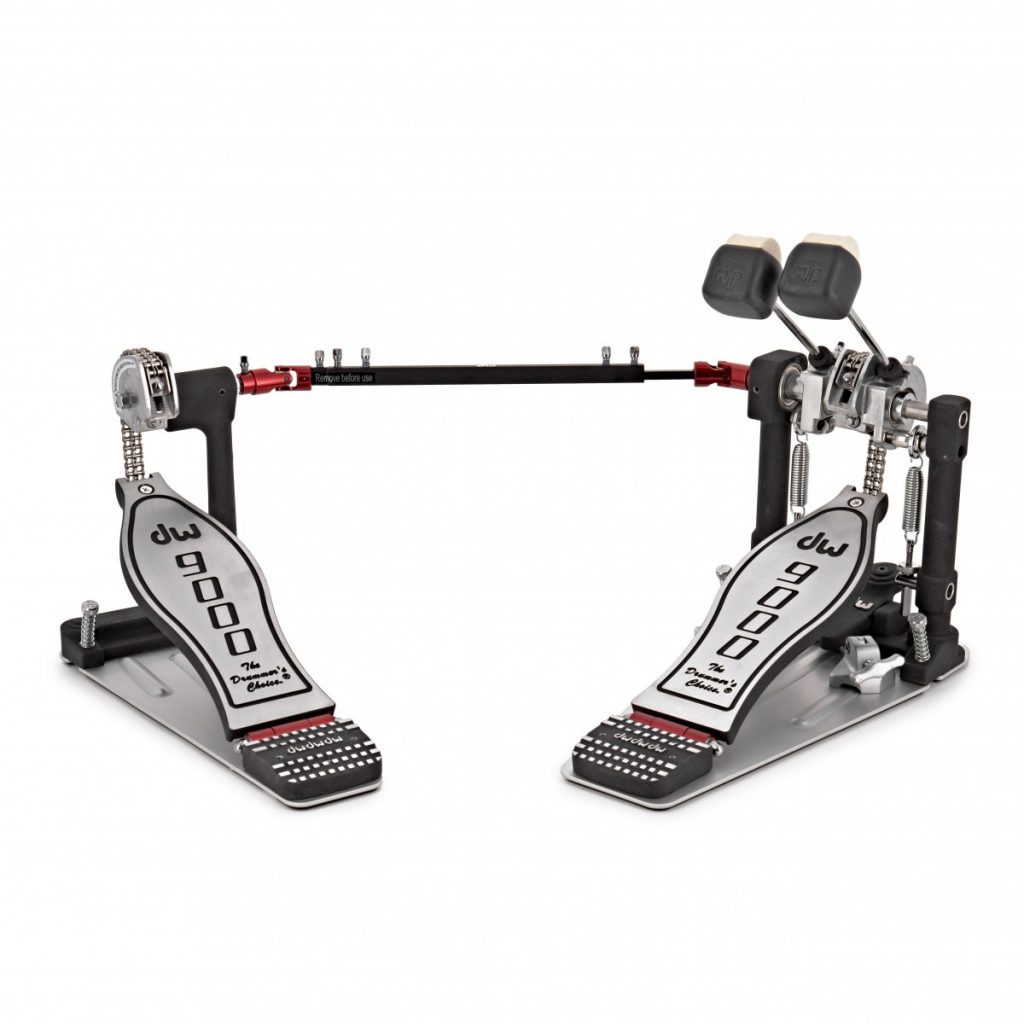
The DW 9002 is the industry standard for double bass drum pedals, with a price to match.
What makes this pedal different to others is its ‘floating rotor’, which is behind its exceptionally smooth and silent action. The rotor is the part of the pedal that the chain is attached to. On the vast majority of pedals, this is attached to a drive shaft, which is free to rotate. On the DW 9002, both the rotor AND the drive shaft are free to rotate. That means the rotor can rotate in two places instead of one, helping to facilitate an even smoother action.
Accompanying this is the placement of the tension springs, which are moved to the interior of the frame instead of the outside as on most drum pedals. In the words of DW, this “vertically aligns” the moving parts, again helping to create a smooth action by reducing lateral movement.
Where other pedals offer interchangeable cams, the 9002 has an infinitely adjustable cam which can be moved from a shorter stroke for speed and control, to a linear action for a 1:1 relationship between the footplate and beater.
All this means that the 9002 is the default choice in the high-end price range, costing around $899/£777/€899 If you’re considering anything else at this price, you have to test drive the 9002 as well to compare against it.
Buy the DW 9002 at Guitar Center or Thomann
Honourable mentions
Roland Noise Eater Double Pedal
The Roland noise eater is the only double bass drum pedal in our round-up that is specifically designed for electronic drums. Each pedal has a built-noise eater pad, which serves to reduce impact noise transmitted through the floor, which reduces the noise that your neighbours hear. This is great for apartment drummers looking to reduce the volume of their set-up.
However, aside from a double chain, the pedal is quite basic and lacks many features that others have at $479/£348/€399. It may be better to go for a more ‘mainstream’ double pedal, and if you want to minimise the volume of your eKit, try our guide on Noise Eater alternatives.
Check it out at Guitar Center or Thomann.
Tama Iron Cobra 900
The Tama HP900 PowerGlide Iron Cobra 900 is the top-of-the-range Iron Cobra pedal, based on a design perfected over many years. Like other pedals here, the Iron Cobra is available with either offset or linear cams, known as the Power Glide or Rolling Glide.
But unlike some other pedals, the cams are not interchangeable – they are two separate products, where PWN in the product code denotes the Power Glide and RWN denotes Rolling Glide. That means the Iron Cobra is great if you know what type of cam you prefer, but not the best choice for drummers who are still experimenting and finding their preferred pedal set-up.
The downside of the Iron Cobra 900 for eDrummers is that the beaters are felt only, which eDrummers should swap for a plastic beater. As a result, it isn’t one of our top picks, unless you already have a pair of plastic beaters to swap over.
For Tama fans on a budget, there is also a 600 variant of the Iron Cobra, which drops some of the advanced features like the cobra coil. Curiously, it adds an adjustable cam which is missing from the higher-end 900 series. It is available at around $319/£250. There is also an Iron Cobra 200 entry-level variant, but as it is very close in price to the 600 at $229/£206, you may as well step up to the 600 range if you want to spend a bit more than our budget options listed in this article.
The 600 and below feature double-sided plastic/felt beaters, making them suitable for eDrums.
Browse the Iron Cobra range at Guitar Center or Thomann.
This article contains affiliate links. If you purchase a product through certain links on our site, we may earn a small affiliate commission. Learn more about our adverts and why you can trust eDrumHub here.
